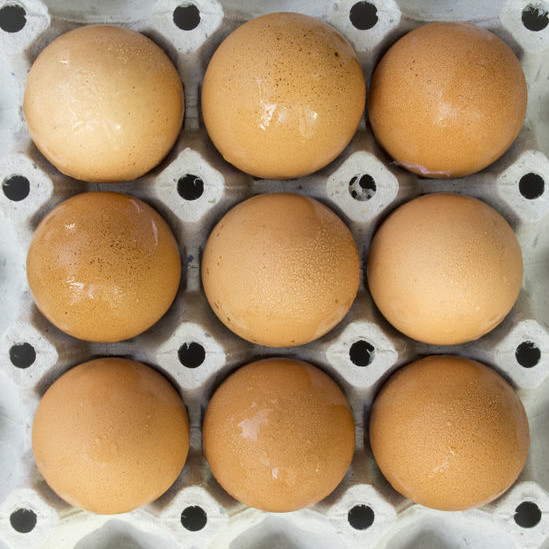
Eggs Spec Sheet
Also known as a technical product data sheet
What is a Eggs Spec Sheet?
An eggs spec sheet for the production of bakery products is a document that expresses and defines the requirements that must be met by egg suppliers in order to comply with bakeries’ ingredient quality specifications and processing conditions.
How does it work?
Spec sheets for eggs should provide maximum, minimum and target values for each technical parameter related to the quality and safety of eggs. Information regarding storage and usage conditions and any other relevant technical information should also be detailed.1
Eggs quality and functionality
Eggs are primarily used in the production of rich bread formulations and sweet goods such as layer cakes and muffins. Eggs’ impact on cakes and other types of chemically-leavened and batter based products is considerable. They can negatively impact the texture of finished products and change processing conditions if not compliant with quality specs.Depending on their form (shell, liquid or dry), eggs perform key functions in bakery products, mainly:
- Source of nutrients: provide considerable amounts of fat, protein and phospholipids
- Desirable color and flavor: crust and crumb through browning reactions
- Moistening agent: liquid forms
- Structure in cake systems due to protein coagulation
- Natural emulsification: presence of lecithin in egg yolks
- Tenderizing
- Leavening: air incorporation in sponge cakes and angel food cakes due to presence of albumins
Application
Eggs spec sheets should contain the following information (divided into sections):2,3,4
- Product definition (e.g. entire/shell eggs, liquid whole eggs, dry whole eggs, dry egg whites)
- Comprehensive section. This section should include egg production description and any other origin-related information.
- Regulatory information (compliance with 21 CFR Part 160)
- Food safety information. Includes any information relevant to consumer safety such as allergenicity.
- Kosher designation (if applicable).
- Organic designation (if applicable). A certifying agency and a certification date or code should also be provided in this section.
- Non GMO and clean label designations (if applicable)
- Sampling analysis plan. This section should describe:
- The procedure for obtaining samples of eggs for analysis (in discrete amounts)
- Frequency of analysis (e.g., per shipment)
- Number of samples required
- Information as to how the samples are physically collected
- Acceptance criteria. This section should include:
- Physical and organoleptic: viscosity for liquid forms, color and smell.
- Analytical specifications for quality parameters: ash, moisture, dry matter, total solids content, fat, protein, total sugars, pH.
- Microbiological specifications: total plate count (<5,000 cfu/g for liquid egg forms, and <10,000 cfu/g for dry forms), mold count (max 10 cfu/g), yeast count (max 10 cfu/g), coliform (max 10 cfu/g) Pathogens Salmonella, E. coli, Bacillus cereus should render negative results.
- Maximum, minimum, target values and/or range of values for each technical parameter
- Testing procedures required for supplier analyses
- Specification of the approved methods for the analyses/test
- Procedure when a test is out of specification. This section should describe what action should be taken when an analysis is out of specification.
- Dosage recommendations. Should include the amount in baker’s % to add according to type of product.
- Recommendations regarding storage conditions. Temperature and relative humidity should be specified in this section.
- Shipping, packaging and shelf-life information. Accurate and relevant details on how the ingredient is handled and transported to the bakery should be provided here. The following info may also be included:
- Shelf-life of ingredient according to recommended packaging and storage conditions.
- Pallet configuration for shipments in boxes (i.e. bags per box, boxes per pallet, gross weight per box, pallet dimensions)
Application
In some cases where a bakery uses different types of eggs from the same supplier (e.g. liquid whole eggs for yellow layer cakes and dry whole eggs for muffins), the spec sheet often contains data and calculation steps to convert from one egg form to another. This is very helpful for bakers who need to troubleshoot unplanned situations related to availability of a given egg form.
The inclusion level and eggs type depend on the finished product and functionality required by the bakery. Each form has its own composition and functional benefits.
| Egg Form | % Protein (dry basis) | % Fat (dry basis) | % Moisture | % Solids |
| Liquid whole | 53.2 | 46.0 | 75.0 | 25.0 |
| Whites (liquid) | 96.6 | 1.7 | 88.0 | 12.0 |
| Yolks (liquid) | 32.7 | 62.0 | 49.0 | 51.0 |
| Dry whole (powder) | – | – | 5.0 | 95.0 |
References
- Nielsen, S.S. “Introduction to Food Analysis.” Food Analysis, 5th edition, Springer International Publishing, 2017, pp. 3–15.
- Kiosseoglou, V., and Paraskevopoulou, A. “Eggs.” Bakery Products Science and Technology, 2nd edition, John Wiley & Sons, Ltd, 2014, pp. 243–255.
- Figoni, P. “Eggs and Eggs Products.” How Baking Works: Exploring the Fundamentals of Baking Science, 3rd edition, John Wiley & Sons, Ltd, 2011, pp. 258–2576.
- Li-Chan, E.C., Powrie, W.D., Nakai, S. “The Chemistry of Eggs and Egg Products.” Egg Science and Technology, 4th edition, Routledge, Taylor & Francis Group, 1995, pp. 105–175.

